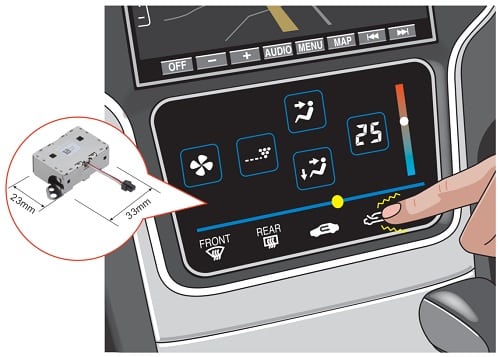Eliminates power issues and offers high-sensitivity for quick response, delivering greater reassurance and safety while driving
 Touch input is becoming prevalent in the automotive market with increased integration and multi-functionality of controls traditionally operated by switches or dials. Even outside the realms of car navigation and audio, use of touch control is expected to keep growing, not only as a design consideration but also due to the convenient user interface (UI) and user experience (UX) that it provides.
Touch input is becoming prevalent in the automotive market with increased integration and multi-functionality of controls traditionally operated by switches or dials. Even outside the realms of car navigation and audio, use of touch control is expected to keep growing, not only as a design consideration but also due to the convenient user interface (UI) and user experience (UX) that it provides.
Meanwhile, HVAC and In-Vehicle Infotainment (IVI) integration has made control more complex. Accidents are occurring while the driver is operating touch controls and not concentrating on the road because they are unsure if their input operation was successful. To address these issues, sound, light and other types of feedback are added to touch controls. There is currently a growing demand for vibrational feedback, which allows more intuitive control and does not require any shift of gaze. The technology acts as a means of delivering greater reassurance and safety while driving. An example is an incorporation into the car’s warning systems – including lane-departure warnings and vehicle proximity alerts that warn the driver of approaching cars – of vibrations in the steering wheel or the driver’s seat.
Responding to these needs, the HAPTIC Reactor Heavy Type has been developed that produces an excitation force of 15G (at 100g). It is for installation behind the front panel of car navigation or other systems. Earlier vibration devices have had many issues, including the need for bigger dimensions and a booster circuit to generate the power required to cause a heavy object (approx. 600g – 1kg), such as a display, to vibrate.
Compact Yet Powerful
The Heavy Type achieves a 15G excitation force at a low frequency (130Hz) despite compact dimensions of 33 × 23 × 13mm (W×D×H) while retaining the typical HAPTIC Reactor characteristics of horizontal resonance, which is easier to perceive with fingertips and has an outstanding response speed. A small input voltage of 7V eliminates the need for a booster circuit, contributing to greater freedom in end product design.
This Heavy Type has a mounting tab and harness connector for greater installation ease. The specifications allow easy incorporation not only behind displays but across the vehicle cabin, such as in the steering wheel, seats and door trims. Ready to work with a driver IC, the device can generate vibration patterns matching the particular conditions and requirements of each end product manufacturer.

Sample shipments will begin in October 2020, destined primarily for the automotive market. Alps Alpine is eyeing a January 2021 start to mass production.






